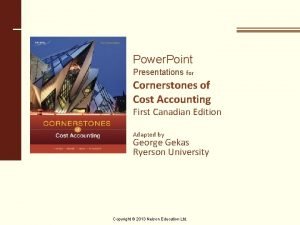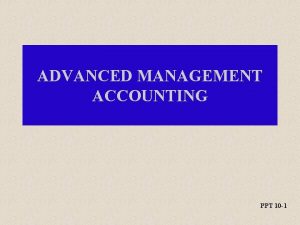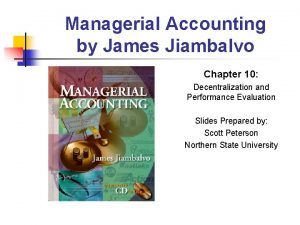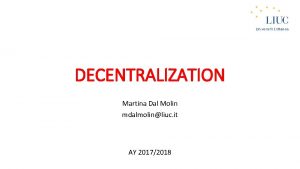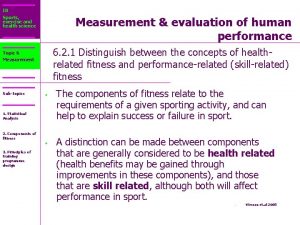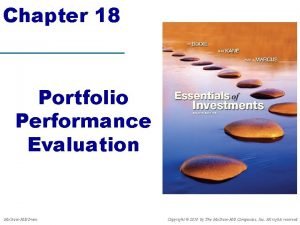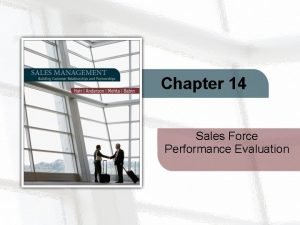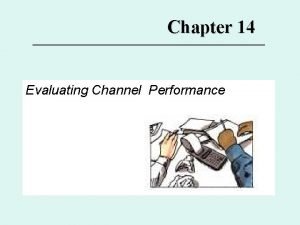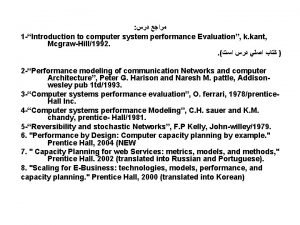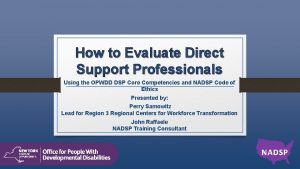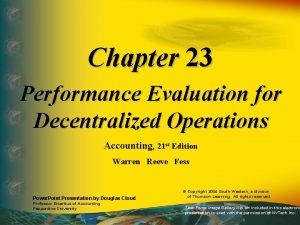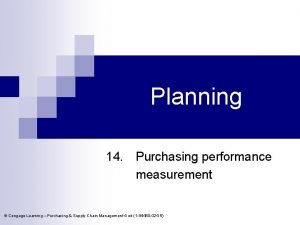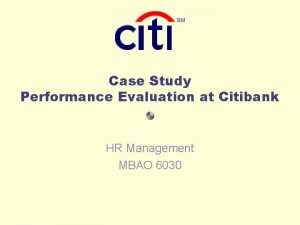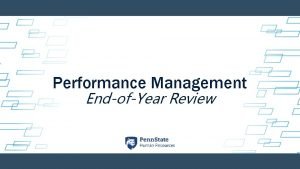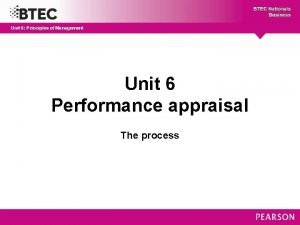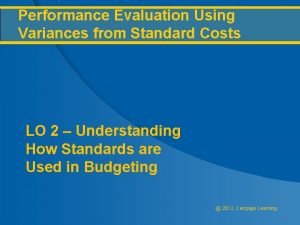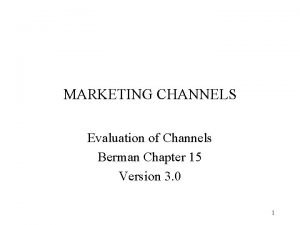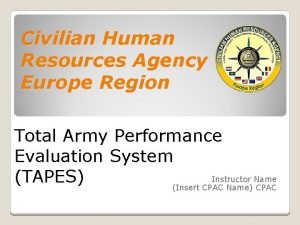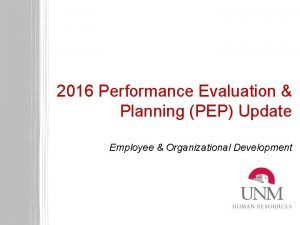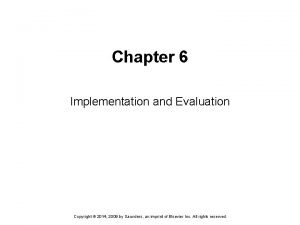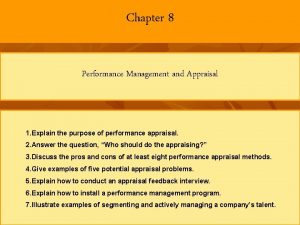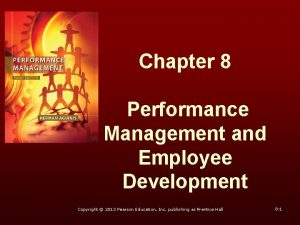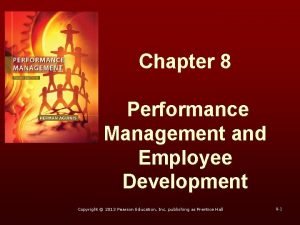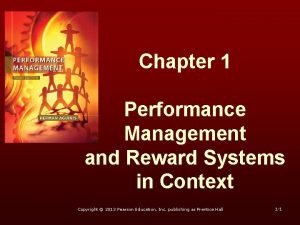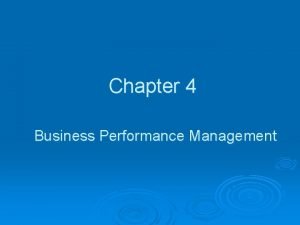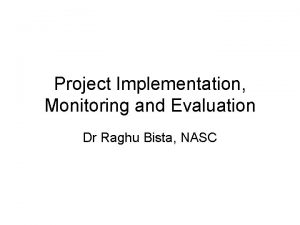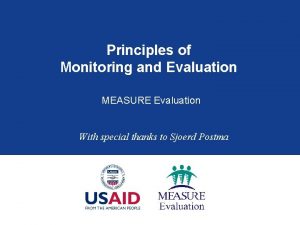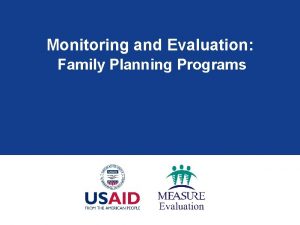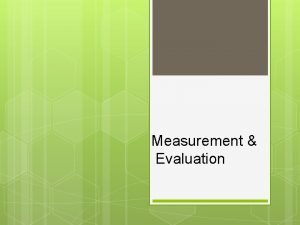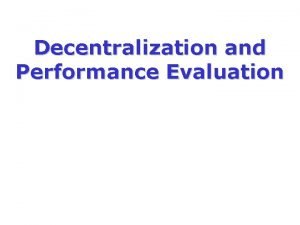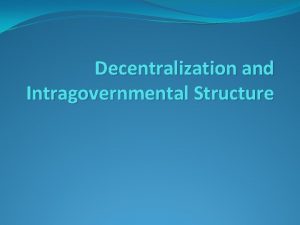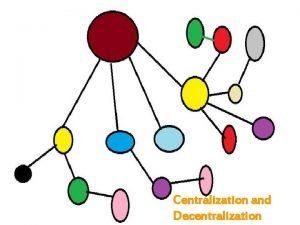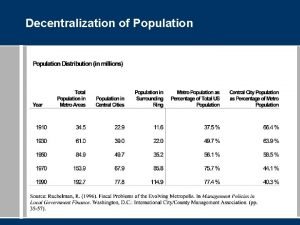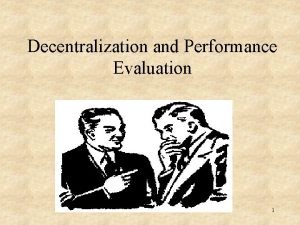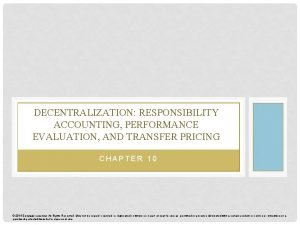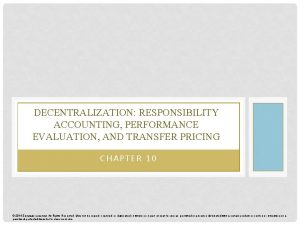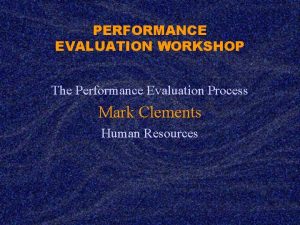Chapter 12 Performance Evaluation and Decentralization Cornerstones of


























































- Slides: 58

Chapter 12: Performance Evaluation and Decentralization Cornerstones of Managerial Accounting, 4 e © 2012 Cengage Learning. All Rights Reserved. May not be copied, scanned, or duplicated, in whole or in part, except for use as permitted in a license distributed with a certain product or service or otherwise on a password-protected website for classroom use.

Learning Objectives 1. Explain how and why firms choose to decentralize. 2. Compute and explain return on investment. 3. Compute and explain residual income and economic value added. 4. Explain the role of transfer pricing in a decentralized firm. 5. (Appendix 12 A) Explain the uses of the Balanced Scorecard, and compute cycle time, velocity, and manufacturing cycle efficiency. © 2012 Cengage Learning. All Rights Reserved. May not be copied, scanned, or duplicated, in whole or in part, except for use as permitted in a license distributed with a certain product or service or otherwise on a password-protected website for classroom use.

1 Decentralization and Responsibility Centers ►In general, a company is organized along lines of responsibility. Today, most companies use a more flattened hierarchy that emphasizes teams. ►Firms with multiple responsibility centers usually choose one of two decision-making approaches to manage their diverse and complex activities: centralized or decentralized. ►In centralized decision making, decisions are made at the very top level, and lower level managers are charged with implementing these decisions. ►Decentralized decision making allows managers at lower levels to make and implement key decisions pertaining to their areas of responsibility. The practice of delegating decision-making authority to the lower levels of management in a company is called decentralization. © 2012 Cengage Learning. All Rights Reserved. May not be copied, scanned, or duplicated, in whole or in part, except for use as permitted in a license distributed with a certain product or service or otherwise on a password-protected website for classroom use.

1 Centralization and Decentralization © 2012 Cengage Learning. All Rights Reserved. May not be copied, scanned, or duplicated, in whole or in part, except for use as permitted in a license distributed with a certain product or service or otherwise on a password-protected website for classroom use.

1 Reasons for Decentralization ►Firms decide to decentralize for several reasons, including the following: ►ease of gathering and using local information ►focusing of central management ►training and motivating of segment managers ►enhanced competition, exposing segments to market forces © 2012 Cengage Learning. All Rights Reserved. May not be copied, scanned, or duplicated, in whole or in part, except for use as permitted in a license distributed with a certain product or service or otherwise on a password-protected website for classroom use.

1 Divisions in the Decentralized Firm ►Decentralization involves a cost-benefit trade-off. ►As a firm becomes more decentralized, it passes more decision authority down the managerial hierarchy. ►Decentralization usually is achieved by creating units called divisions. ►Divisions can be differentiated a number of different ways, including the following: ►types of goods or services ►geographic lines ►responsibility centers © 2012 Cengage Learning. All Rights Reserved. May not be copied, scanned, or duplicated, in whole or in part, except for use as permitted in a license distributed with a certain product or service or otherwise on a password-protected website for classroom use.

1 Types of Goods or Services ► Here is an example of how PEPSICO creates its decentralized divisions organized according to the product lines it makes. ► In a decentralized setting, some interdependencies usually exist, like Pepsi being sold at its restaurants, which include Pizza Hut, Taco Bell and KFC. © 2012 Cengage Learning. All Rights Reserved. May not be copied, scanned, or duplicated, in whole or in part, except for use as permitted in a license distributed with a certain product or service or otherwise on a password-protected website for classroom use.

1 Geographic Lines ►Divisions may also be created along geographic lines. ►The presence of divisions spanning one or more regions creates the need for performance evaluation that can take into account differences in divisional environments. © 2012 Cengage Learning. All Rights Reserved. May not be copied, scanned, or duplicated, in whole or in part, except for use as permitted in a license distributed with a certain product or service or otherwise on a password-protected website for classroom use.

1 Responsibility Centers ► A third way divisions differ is by the type of responsibility given to the divisional manager. ► A responsibility center is a segment of the business whose manager is accountable for specified sets of activities. ► The four major types of responsibility centers are as follows: ►Cost center: Manager is responsible only for costs. ►Revenue center: Manager is responsible only for sales, or revenue. ►Profit center: Manager is responsible for both revenues and costs. ►Investment center: Manager is responsible for revenues, costs, and investments. © 2012 Cengage Learning. All Rights Reserved. May not be copied, scanned, or duplicated, in whole or in part, except for use as permitted in a license distributed with a certain product or service or otherwise on a password-protected website for classroom use.

Responsibility Centers and Accounting Information Used to Measure 1 Performance Investment centers represent the greatest degree of decentralization (followed by profit centers and finally by cost and revenue centers) because their managers have the freedom to make the greatest variety of decisions. © 2012 Cengage Learning. All Rights Reserved. May not be copied, scanned, or duplicated, in whole or in part, except for use as permitted in a license distributed with a certain product or service or otherwise on a password-protected website for classroom use.

1 Responsibility Center Interdependencies ►It is important to realize that while the responsibility center manager has responsibility only for the activities of that center, decisions made by that manager can affect other responsibility centers. ►Organizing divisions as responsibility centers creates the opportunity to control the divisions through the use of responsibility accounting. © 2012 Cengage Learning. All Rights Reserved. May not be copied, scanned, or duplicated, in whole or in part, except for use as permitted in a license distributed with a certain product or service or otherwise on a password-protected website for classroom use.

1 You Decide Organizational Structure © 2012 Cengage Learning. All Rights Reserved. May not be copied, scanned, or duplicated, in whole or in part, except for use as permitted in a license distributed with a certain product or service or otherwise on a password-protected website for classroom use.

2 Return on Investment ►One way to relate operating profits to assets employed is to compute the return on investment (ROI), which is the profit earned per dollar of investment. ►ROI is the most common measure of performance for an investment center and is computed as follows: Operating income ÷ Average Operating Assets ►Operating income refers to earnings before interest and taxes. ►Operating assets are all assets acquired to generate operating income, including cash, receivables, inventories, land, buildings, and equipment. ►Average operating assets is computed as: (Beginning assets + Ending assets) ÷ 2 © 2012 Cengage Learning. All Rights Reserved. May not be copied, scanned, or duplicated, in whole or in part, except for use as permitted in a license distributed with a certain product or service or otherwise on a password-protected website for classroom use.

2 Margin and Turnover ►A second way to calculate ROI is to separate the formula (Operating income ÷ Average operating assets) into margin and turnover. ►Margin is the ratio of operating income to sales. ►It tells how many cents of operating income result from each dollar of sales; it expresses the portion of sales that is available for interest, taxes, and profit. ►Turnover is sales ÷ average operating assets. ►Turnover tells how many dollars of sales result from every dollar invested in operating assets. © 2012 Cengage Learning. All Rights Reserved. May not be copied, scanned, or duplicated, in whole or in part, except for use as permitted in a license distributed with a certain product or service or otherwise on a password-protected website for classroom use.

2 Margin and Turnover (continued) ►The equation that yields ROI from the Margin and Turnover is as follows: Margin Turnover ROI = Operating Income X Sales Average Operating Assets Notice that ‘‘Sales’’ in the above formula can be cancelled out to yield the original ROI formula of Operating income/Average operating assets. © 2012 Cengage Learning. All Rights Reserved. May not be copied, scanned, or duplicated, in whole or in part, except for use as permitted in a license distributed with a certain product or service or otherwise on a password-protected website for classroom use.

2 Cornerstone 12 -1 Calculating Average Operating Assets, Margin, Turnover, and Return on Investment © 2012 Cengage Learning. All Rights Reserved. May not be copied, scanned, or duplicated, in whole or in part, except for use as permitted in a license distributed with a certain product or service or otherwise on a password-protected website for classroom use.

2 Cornerstone 12 -1 Calculating Average Operating Assets, Margin, Turnover, and Return on Investment (continued) © 2012 Cengage Learning. All Rights Reserved. May not be copied, scanned, or duplicated, in whole or in part, except for use as permitted in a license distributed with a certain product or service or otherwise on a password-protected website for classroom use.

2 Advantages of Return on Investment ►At least three positive results stem from the use of ROI: ►It encourages managers to focus on the relationship among sales, expenses, and investment, as should be the case for a manager of an investment center. ►It encourages managers to focus on cost efficiency. ►It encourages managers to focus on operating asset efficiency. © 2012 Cengage Learning. All Rights Reserved. May not be copied, scanned, or duplicated, in whole or in part, except for use as permitted in a license distributed with a certain product or service or otherwise on a password-protected website for classroom use.

2 Disadvantages of the Return on Investment Measure ►Overemphasis on ROI can produce myopic behavior. ►Two negative aspects associated with ROI frequently are: ►It can produce a narrow focus on divisional profitability at the expense of profitability for the overall firm. ►It encourages managers to focus on the short run at the expense of the long run. © 2012 Cengage Learning. All Rights Reserved. May not be copied, scanned, or duplicated, in whole or in part, except for use as permitted in a license distributed with a certain product or service or otherwise on a password-protected website for classroom use.

3 Residual Income ►To compensate for the tendency of ROI to discourage investments that are profitable for a company but that lower a division’s ROI, some companies have adopted alternative performance measures such as residual income. ►Residual income is the difference between operating income and the minimum dollar return required on a company’s operating assets: Residual income = Operating income – (Minimum rate of return x Average operating assets) © 2012 Cengage Learning. All Rights Reserved. May not be copied, scanned, or duplicated, in whole or in part, except for use as permitted in a license distributed with a certain product or service or otherwise on a password-protected website for classroom use.

3 Cornerstone 12 -2 Calculating Residual Income © 2012 Cengage Learning. All Rights Reserved. May not be copied, scanned, or duplicated, in whole or in part, except for use as permitted in a license distributed with a certain product or service or otherwise on a password-protected website for classroom use.

3 Cornerstone 12 -2 Calculating Residual Income (continued) © 2012 Cengage Learning. All Rights Reserved. May not be copied, scanned, or duplicated, in whole or in part, except for use as permitted in a license distributed with a certain product or service or otherwise on a password-protected website for classroom use.

3 Advantage of Residual Income ►The advantage of using residual income is that its use encourages managers to accept any project that earns a return that is above the minimum rate. ►This prevents the fallacy of using ROI that may reject a profitable project that reduces divisional ROI. © 2012 Cengage Learning. All Rights Reserved. May not be copied, scanned, or duplicated, in whole or in part, except for use as permitted in a license distributed with a certain product or service or otherwise on a password-protected website for classroom use.

3 Disadvantages of Residual Income ►Unfortunately, residual income, like ROI, can encourage a short-run orientation. ►Another problem with residual income is that, unlike ROI, it is an absolute measure of profitability. Thus, direct comparison of the performance of two different investment centers becomes difficult, as the level of investment may differ. ►One possible way to correct this disadvantage is to compute both ROI and residual income and to use both measures for performance evaluation. ROI could then be used for interdivisional comparisons. © 2012 Cengage Learning. All Rights Reserved. May not be copied, scanned, or duplicated, in whole or in part, except for use as permitted in a license distributed with a certain product or service or otherwise on a password-protected website for classroom use.

3 Economic Value Added (EVA) ►Another financial performance measure that is similar to residual income is economic value added. ►Economic value added (EVA) is after tax operating income minus the dollar cost of capital employed. ►The dollar cost of capital employed is the actual percentage cost of capital multiplied by the total capital employed. ►EVA is expressed as follows: © 2012 Cengage Learning. All Rights Reserved. May not be copied, scanned, or duplicated, in whole or in part, except for use as permitted in a license distributed with a certain product or service or otherwise on a password-protected website for classroom use.

3 Cornerstone 12 -3 Calculating Economic Value-Added © 2012 Cengage Learning. All Rights Reserved. May not be copied, scanned, or duplicated, in whole or in part, except for use as permitted in a license distributed with a certain product or service or otherwise on a password-protected website for classroom use.

3 Cornerstone 12 -3 Calculating Economic Value-Added (continued) © 2012 Cengage Learning. All Rights Reserved. May not be copied, scanned, or duplicated, in whole or in part, except for use as permitted in a license distributed with a certain product or service or otherwise on a password-protected website for classroom use.

3 Behavioral Aspects of Economic Value Added ► The key feature of EVA is its emphasis on after-tax operating profit and the actual cost of capital. ► Investors like EVA because it relates profit to the amount of resources needed to achieve it. ► A number of companies have discovered that EVA helps to encourage the right kind of behavior from their divisions in a way that emphasis on operating income alone cannot. The underlying reason is EVA’s reliance on the true cost of capital. ► In some companies, the responsibility for investment decisions rests with corporate management. As a result, the cost of capital is considered a corporate expense rather than an expense attributable to particular divisions. ► Without an EVA analysis, the result of investments do not show up as reducing divisional operating income and may seem free to divisions who want more. © 2012 Cengage Learning. All Rights Reserved. May not be copied, scanned, or duplicated, in whole or in part, except for use as permitted in a license distributed with a certain product or service or otherwise on a password-protected website for classroom use.

4 Transfer Pricing ►In many decentralized organizations, the output of one division is used as the input of another. ►As a result, the value of the transferred good is revenue to the selling division and cost to the buying division. ►This value, or internal price, is called the transfer price. ►Transfer price is the price charged for a component by the selling division to the buying division of the same company. © 2012 Cengage Learning. All Rights Reserved. May not be copied, scanned, or duplicated, in whole or in part, except for use as permitted in a license distributed with a certain product or service or otherwise on a password-protected website for classroom use.

4 Impact of Transfer Pricing on Divisions and the Firm as a Whole ►When one division of a company sells to another division, both divisions as well as the company as a whole are affected. ►The price charged for the transferred good affects both ►the costs of the buying division ►the revenues of the selling division ►Thus, the profits of both divisions, as well as the evaluation and compensation of their managers, are affected by the transfer price. © 2012 Cengage Learning. All Rights Reserved. May not be copied, scanned, or duplicated, in whole or in part, except for use as permitted in a license distributed with a certain product or service or otherwise on a password-protected website for classroom use.

4 Impact of Transfer Pricing on Divisions and the Firm as a Whole (continued) ► Since profit-based performance measures of the two divisions are affected, transfer pricing often can be an emotionally charged issue. The above exhibit illustrates the effect of the transfer price on two divisions of a company. Division A wants the transfer price to be as high as possible while Division C prefers it to be as low a as possible. © 2012 Cengage Learning. All Rights Reserved. May not be copied, scanned, or duplicated, in whole or in part, except for use as permitted in a license distributed with a certain product or service or otherwise on a password-protected website for classroom use.

4 Transfer Pricing Policies ►Several transfer pricing policies are used in practice, including: ►market price ►cost-based transfer prices ►negotiated transfer prices © 2012 Cengage Learning. All Rights Reserved. May not be copied, scanned, or duplicated, in whole or in part, except for use as permitted in a license distributed with a certain product or service or otherwise on a password-protected website for classroom use.

4 Transfer Pricing Policies: Market Price ►If there is a competitive outside market for the transferred product, then the best transfer price is the market price. ►In such a case, divisional managers’ actions will simultaneously optimize divisional profits and firm-wide profits. ►Furthermore, no division can benefit at the expense of another. In this setting, top management will not be tempted to intervene. ►The market price, if available, is the best approach to transfer pricing. © 2012 Cengage Learning. All Rights Reserved. May not be copied, scanned, or duplicated, in whole or in part, except for use as permitted in a license distributed with a certain product or service or otherwise on a password-protected website for classroom use.

4 Transfer Pricing Policies: Cost-Based Transfer Prices ►Frequently, there is no good outside market price. ►The lack of a market price might occur because the transferred product uses patented designs owned by the parent company. ►Then, a company might use a cost-based transfer pricing approach. ►Since a transfer price at cost does not allow for any profit for the selling division, top management may define cost as ‘‘cost plus, ’’ which allows a certain percentage to be tacked onto the cost. © 2012 Cengage Learning. All Rights Reserved. May not be copied, scanned, or duplicated, in whole or in part, except for use as permitted in a license distributed with a certain product or service or otherwise on a password-protected website for classroom use.

4 Transfer Pricing Policies: Negotiated Transfer Prices ►Finally, top management may allow the selling and buying division managers to negotiate a transfer price. ►This approach is particularly useful in cases with market imperfections, such as the ability of an in-house division to avoid selling and distribution costs that external market participants would have to incur. ►Using a negotiated transfer price then allows the two divisions to share any cost savings resulting from avoided costs. © 2012 Cengage Learning. All Rights Reserved. May not be copied, scanned, or duplicated, in whole or in part, except for use as permitted in a license distributed with a certain product or service or otherwise on a password-protected website for classroom use.

4 Negotiated Transfer Prices: Bargaining Range ►When using negotiated transfer prices, a bargaining range exists. ►Minimum Transfer Price (Floor): The transfer price that would leave the selling division no worse off if the good were sold to an internal division than if the good were sold to an external party. This is sometimes referred to as the ‘‘floor’’ of the bargaining range. ►Maximum Transfer Price (Ceiling): The transfer price that would leave the buying division no worse off if an input were purchased from an internal division than if the same good were purchased externally. This is sometimes referred to as the ‘‘ceiling’’ of the bargaining range. © 2012 Cengage Learning. All Rights Reserved. May not be copied, scanned, or duplicated, in whole or in part, except for use as permitted in a license distributed with a certain product or service or otherwise on a password-protected website for classroom use.

4 Cornerstone 12 -4 Calculating Transfer Price © 2012 Cengage Learning. All Rights Reserved. May not be copied, scanned, or duplicated, in whole or in part, except for use as permitted in a license distributed with a certain product or service or otherwise on a password-protected website for classroom use.

4 Cornerstone 12 -4 Calculating Transfer Price (continued) © 2012 Cengage Learning. All Rights Reserved. May not be copied, scanned, or duplicated, in whole or in part, except for use as permitted in a license distributed with a certain product or service or otherwise on a password-protected website for classroom use.

Appendix 12 A: The Balanced Scorecard – Basic 5 Concepts ► Segment income, ROI, residual income, and EVA are important measures of managerial performance, but they lead managers to focus only on dollar figures. ► The Balanced Scorecard translates an organization’s mission and strategy into operational objectives and performance measures for the following four perspectives: ► The financial perspective describes the economic consequences of actions taken in the other three perspectives. ► The customer perspective defines the customer and market segments in which the business unit will compete. ► The internal business process perspective describes the internal processes needed to provide value for customers and owners. ► The learning and growth perspective defines the capabilities that an organization needs to create long-term growth and improvement. © 2012 Cengage Learning. All Rights Reserved. May not be copied, scanned, or duplicated, in whole or in part, except for use as permitted in a license distributed with a certain product or service or otherwise on a password-protected website for classroom use.

5 The Balanced Scorecard – An Example © 2012 Cengage Learning. All Rights Reserved. May not be copied, scanned, or duplicated, in whole or in part, except for use as permitted in a license distributed with a certain product or service or otherwise on a password-protected website for classroom use.

5 Strategy Translation ► Strategy specifies management’s desired relationships among the four perspectives. ► Strategy translation, on the other hand, means specifying objectives, measures, targets, and initiatives for each perspective. Here is an example for the financial perspective. ► Objective: For the financial perspective, a company’s objective may be to grow revenues by introducing new products. ► Measure: The performance measure may be the percentage of revenues from the sale of new products. ► Target: The target or standard for the coming year for the measure may be 20 percent (i. e. , 20 percent of the total revenues for the coming year must be from the sale of new products). ► Initiative: The initiative describes how this is to be accomplished. The ‘‘how, ’’ of course, involves the other three perspectives. © 2012 Cengage Learning. All Rights Reserved. May not be copied, scanned, or duplicated, in whole or in part, except for use as permitted in a license distributed with a certain product or service or otherwise on a password-protected website for classroom use.

5 The Role of Performance Measures ► The Balanced Scorecard is not simply a collection of critical performance measures. ► The performance measures are derived from a company’s vision, strategy, and objectives. ► These measures must be balanced between the following measures: ►performance driver measures (i. e. , lead indicators of future financial performance) and outcome measures (i. e. , lagged indicators of financial performance) ►objective and subjective measures ►external and internal measures ►financial and nonfinancial measures © 2012 Cengage Learning. All Rights Reserved. May not be copied, scanned, or duplicated, in whole or in part, except for use as permitted in a license distributed with a certain product or service or otherwise on a password-protected website for classroom use.

5 Linking Performance Measures to Strategy ►Balancing outcome measures with performance drivers is essential to linking with the organization’s strategy. ►Performance drivers make things happen and are indicators of how the outcomes are going to be realized. ►Outcome measures are also important because they reveal whether the strategy is being implemented successfully with the desired economic consequences. ►A testable strategy can be defined as a set of linked objectives aimed at an overall goal. © 2012 Cengage Learning. All Rights Reserved. May not be copied, scanned, or duplicated, in whole or in part, except for use as permitted in a license distributed with a certain product or service or otherwise on a password-protected website for classroom use.

5 A Testable Strategy Example © 2012 Cengage Learning. All Rights Reserved. May not be copied, scanned, or duplicated, in whole or in part, except for use as permitted in a license distributed with a certain product or service or otherwise on a password-protected website for classroom use.

5 Invalid Strategy ►If the targeted levels of performance drivers were achieved and the expected outcomes did not materialize, then the problem could very well lie with the strategy itself. ►Double-loop feedback occurs whenever managers receive information about both the effectiveness of strategy implementation as well as the validity of the assumptions underlying the strategy. ►In a functional-based responsibility accounting system, typically only single-loop feedback is provided. ►Single-loop feedback emphasizes only effectiveness of implementation. ►In single-loop feedback, actual results deviating from planned results are a signal to take corrective action so that the plan (strategy) can be executed as intended. © 2012 Cengage Learning. All Rights Reserved. May not be copied, scanned, or duplicated, in whole or in part, except for use as permitted in a license distributed with a certain product or service or otherwise on a password-protected website for classroom use.

5 The Four Perspectives and Performance Measures ►The four perspectives define the strategy of an organization and provide the structure or framework for developing an integrated, cohesive set of performance measures. ►These measures, once developed, become the means for articulating and communicating the strategy of the organization to its employees and managers. ►The measures also serve the purpose of aligning individual objectives and actions with organizational objectives and initiatives. © 2012 Cengage Learning. All Rights Reserved. May not be copied, scanned, or duplicated, in whole or in part, except for use as permitted in a license distributed with a certain product or service or otherwise on a password-protected website for classroom use.

5 The Financial Perspective © 2012 Cengage Learning. All Rights Reserved. May not be copied, scanned, or duplicated, in whole or in part, except for use as permitted in a license distributed with a certain product or service or otherwise on a password-protected website for classroom use.

5 Customer Perspective ► The customer perspective is the source of the revenue component for the financial objectives. ► It defines and selects the customer and market segments in which the company chooses to compete. © 2012 Cengage Learning. All Rights Reserved. May not be copied, scanned, or duplicated, in whole or in part, except for use as permitted in a license distributed with a certain product or service or otherwise on a password-protected website for classroom use.

5 Internal (Process) Perspective ► The internal perspective typically focuses on identifying the organization’s core internal business processes needed for creating customer and shareholder value to achieve the customer and financial objectives. ► The framework for this perspective is the process value chain, made up of three processes: ► The innovation process anticipates the emerging and potential needs of customers and creates new products and services to satisfy those needs. It represents what is called the long-wave of value creation. ► The operations process produces and delivers existing products and services to customers. It begins with a customer order and ends with the delivery of the product or service. It is the short-wave of value creation. ► The postsales service process provides critical and responsive services to customers after the product or service has been delivered. © 2012 Cengage Learning. All Rights Reserved. May not be copied, scanned, or duplicated, in whole or in part, except for use as permitted in a license distributed with a certain product or service or otherwise on a password-protected website for classroom use.

5 Internal (Process) Perspective (continued) © 2012 Cengage Learning. All Rights Reserved. May not be copied, scanned, or duplicated, in whole or in part, except for use as permitted in a license distributed with a certain product or service or otherwise on a password-protected website for classroom use.

5 Responsiveness: Cycle Time and Velocity ►The time to respond to a customer order is referred to as responsiveness. Cycle time and velocity are two operational measures of responsiveness. ►Cycle time is the length of time it takes to produce a unit of output from the time raw materials are received (starting point of the cycle) until the good is delivered to finished goods inventory (finishing point of the cycle). ►Thus, cycle time is the time required to produce a product (Time ÷ Units produced). ►Velocity is the number of units of output that can be produced in a given period of time (Units produced ÷ Time). © 2012 Cengage Learning. All Rights Reserved. May not be copied, scanned, or duplicated, in whole or in part, except for use as permitted in a license distributed with a certain product or service or otherwise on a password-protected website for classroom use.

5 Cornerstone 12 -5 Computing Cycle Time and Velocity © 2012 Cengage Learning. All Rights Reserved. May not be copied, scanned, or duplicated, in whole or in part, except for use as permitted in a license distributed with a certain product or service or otherwise on a password-protected website for classroom use.

5 Cornerstone 12 -5 Computing Cycle Time and Velocity (continued) © 2012 Cengage Learning. All Rights Reserved. May not be copied, scanned, or duplicated, in whole or in part, except for use as permitted in a license distributed with a certain product or service or otherwise on a password-protected website for classroom use.

5 Manufacturing Cycle Efficiency ►Another time based operational measure calculates MCE (manufacturing cycle efficiency). ►MCE is measured as value-added time ÷ total time. ►Total time includes both value-added time (the time spent efficiently producing the product) and nonvalue-added time (such as move time, inspection time, and waiting time). ►The formula for computing MCE is: © 2012 Cengage Learning. All Rights Reserved. May not be copied, scanned, or duplicated, in whole or in part, except for use as permitted in a license distributed with a certain product or service or otherwise on a password-protected website for classroom use.

5 Cornerstone 12 -6 Calculating Manufacturing Cycle Efficiency © 2012 Cengage Learning. All Rights Reserved. May not be copied, scanned, or duplicated, in whole or in part, except for use as permitted in a license distributed with a certain product or service or otherwise on a password-protected website for classroom use.

5 Cornerstone 12 -6 Calculating Manufacturing Cycle Efficiency (continued) © 2012 Cengage Learning. All Rights Reserved. May not be copied, scanned, or duplicated, in whole or in part, except for use as permitted in a license distributed with a certain product or service or otherwise on a password-protected website for classroom use.

5 Learning and Growth Perspective ► The learning and growth perspective, which represents the source of the capabilities that enable the accomplishment of the other three perspectives’ objectives. ► This perspective has three major objectives: ► increase employee capabilities ► increase motivation, empowerment, and alignment ► increase information systems capabilities ► Employees must not only have the necessary skills, but they must also have the freedom, motivation, and initiative to use those skills effectively. ► Additionally, it is important to increase information system capabilities so employees can improve processes and effectively execute new processes. © 2012 Cengage Learning. All Rights Reserved. May not be copied, scanned, or duplicated, in whole or in part, except for use as permitted in a license distributed with a certain product or service or otherwise on a password-protected website for classroom use.

5 Learning and Growth Perspective (continued) © 2012 Cengage Learning. All Rights Reserved. May not be copied, scanned, or duplicated, in whole or in part, except for use as permitted in a license distributed with a certain product or service or otherwise on a password-protected website for classroom use.
 Cornerstones of cost accounting
Cornerstones of cost accounting Identify the cornerstones of the wellness movement
Identify the cornerstones of the wellness movement Decentralization and transfer pricing ppt
Decentralization and transfer pricing ppt Midwest mfg uses a balanced scorecard
Midwest mfg uses a balanced scorecard Decentralization accounting
Decentralization accounting Decentralization
Decentralization Decentralization
Decentralization Decentralization
Decentralization Centralization vs decentralization
Centralization vs decentralization Decentralization
Decentralization Decentralization policy
Decentralization policy Advantages of decentralization
Advantages of decentralization Progress and performance measurement and evaluation
Progress and performance measurement and evaluation Progress and performance measurement and evaluation
Progress and performance measurement and evaluation Measurement and evaluation in human performance 5e download
Measurement and evaluation in human performance 5e download How to measure standing vertical jump
How to measure standing vertical jump Computer architecture performance evaluation methods
Computer architecture performance evaluation methods Portfolio performance evaluation problems
Portfolio performance evaluation problems Sales team evaluation
Sales team evaluation Three phases in the channel member performance audit
Three phases in the channel member performance audit Computer systems performance analysis
Computer systems performance analysis Mmsb usmc
Mmsb usmc Direct support professional performance evaluation
Direct support professional performance evaluation Performance evaluation for decentralized operations
Performance evaluation for decentralized operations Evaluating purchasing performance
Evaluating purchasing performance Citibank performance evaluation case study
Citibank performance evaluation case study Housekeeping performance improvement plan
Housekeeping performance improvement plan Unit 6 principles of management sample answers
Unit 6 principles of management sample answers Stronge leader effectiveness performance evaluation model
Stronge leader effectiveness performance evaluation model Performance evaluation using variances from standard costs
Performance evaluation using variances from standard costs Library staff performance evaluation
Library staff performance evaluation Channel performance evaluation
Channel performance evaluation Performance evaluation model
Performance evaluation model Da form 7223
Da form 7223 Pep performance evaluation
Pep performance evaluation Performance levels
Performance levels Behaviorally anchored rating scale
Behaviorally anchored rating scale Jcids process
Jcids process Chapter 6 implementation and evaluation
Chapter 6 implementation and evaluation Chapter 11 assessment and evaluation of sports injuries
Chapter 11 assessment and evaluation of sports injuries Chapter 9 flexible budget and performance analysis
Chapter 9 flexible budget and performance analysis Performance management and appraisal chapter 8
Performance management and appraisal chapter 8 Performance management and appraisal chapter 8
Performance management and appraisal chapter 8 Performance management and appraisal chapter 8
Performance management and appraisal chapter 8 Sensory evaluation cryptogram answers
Sensory evaluation cryptogram answers Chapter 3 sensory evaluation the human factor
Chapter 3 sensory evaluation the human factor Chapter 3 sensory evaluation the human factor
Chapter 3 sensory evaluation the human factor Picme2.0
Picme2.0 Performance management reward system
Performance management reward system What is the fundamental challenge of dashboard design
What is the fundamental challenge of dashboard design Simons and chabris
Simons and chabris M&e cycle
M&e cycle Comparison between monitoring and evaluation
Comparison between monitoring and evaluation Putting it all to bed during project closeout includes
Putting it all to bed during project closeout includes Project evaluation and control
Project evaluation and control Principles of monitoring and evaluation
Principles of monitoring and evaluation M&e dashboard
M&e dashboard Monitoring and evaluation of family planning programs
Monitoring and evaluation of family planning programs Concept map of measurement assessment and evaluation
Concept map of measurement assessment and evaluation
